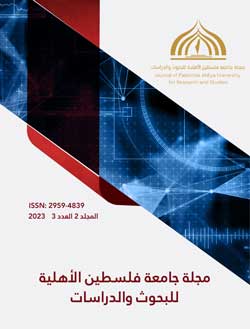تأثير حجم التداول وسعر الصرف على سعر مؤشر إسطنبول: النتائج التجريبية باستخدام نموذج ARDL
DOI:
https://doi.org/10.59994/pau.2023.3.114الكلمات المفتاحية:
سعر الصرف، اختبار ARDL، حجم التداول، سعر السهم، مؤشر بورصة اسطنبول، CUSUM، CUSUM-of-squareالملخص
تهدف هذه الدراسة إلى تحليل العلاقة بين التغيّر في حجم التداول وسعر صرف الليرة التركية وأثر ذلك على سعر أسهم الشركات المُدرجة في بورصة اسطنبول. تم التوصل إلى ذلك من خلال جمع بيانات أسبوعية عن قيم مؤشر بورصة اسطنبول (BIST 100)إضافة إلى حجم التداول وسعر الصرف لليرة التركية مقابل الدولار الأمريكي في الفترة الواقعة ما بين 2016-2021. تم إجراء اختبارات تشخيصية للتأكّد من أن البيانات المستخدمة تتناسب مع خصائص النموذج المستخدم من خلال اختبار جذر الوحدة الذي أظهر أن المتغير التابع مستقر بعد الفرق الأول والمتغيرات الأخرى مستقرة في المستوى الأصلي وبعد الفرق الأول أيضًا. وأظهرت الاختبارات أن البواقي تتناسب مع الحالة الرئيسة حيث يتطلب أن تكون غير مرتبطة بشكل متسلسل مع المنحدر المتجانس، ومن خلال استخدام منهجية الانحدار الذاتي للفجوات الزمنية الموزعة (ARDL) لاستكشاف العلاقة والتفاعل على المدى القصير والطويل بين المتغيرات تبين أن هناك علاقة بين المتغيرات التابعة والمستقلة على المدى الطويل، حيث أظهرت النتائج أن سعر الصرف له تأثير سلبي ذي دلالة إحصائية على أسعار الأسهم المُدرجة في بورصة اسطنبول بينما حجم التداول له تأثير ضئيل على المدى الطويل.
ومع ذلك، فإنّ نتائج التكامل المشترك على المدى القصير مختلفة. وكانت القيمة الحالية والسابقة لحجم التداول ذات دلالة إحصائية كبيرة. وأخيرًا تم اختبار استقرار النموذج فكانت النتائج مختلفة بين CUSUM وCUSUMSQ. حيث أظهرت نتائج CUSUM بأن هناك استقرار في النموذج وعلى النقيض من ذلك أظهرت نتائج CUSUMSQ أن معاملات الانحدار غير ثابتة.
التنزيلات
المراجع
Bhattacharya, S. N., Bhattacharya, M., & Basu, S. (2019). Stock market and its liquidity: Evidence from ARDL bound testing approach in the Indian context. Cogent Economics & Finance. 7:1, DOI: 10.1080/23322039.2019.1586297
Brown, R. L., Durbin, J., & Evans, J. M. (1975). Techniques for testing the constancy of regression relationships over time. Journal of the Royal Statistical Society Series B: Statistical Methodology, 37(2), 149-163.
Camba, A. (2020). The Sino‐centric capital export regime: State‐backed and flexible capital in the Philippines. Development and Change, 51(4), 970-997.
Campbell, J. Y., & Shiller, R. J. (1988). The dividend-price ratio and expectations of future dividends and discount factors. The Review of Financial Studies, 1(3), 195-228.
Caporale, G. M., & Pittis, N. (2004). Robustness of the CUSUM and CUSUM-of-squares tests to serial correlation, endogeneity and lack of Structural invariance: Some Monte Carlo evidence (No. 157). Reihe Ökonomie/Economics Series.
Chandrapala, P. (2011). The relationship between trading volume and stock returns. Journal of Competitiveness, 41-49.
Dhaoui, A., & Bacha, S. (2017). Investor emotional biases and trading volume’s asymmetric response: A non-linear ARDL approach tested in S&P500 stock market. Cogent economics & finance, 5(1), 1274225.
Gordon, M. J. (1959). Dividends, earnings, and stock prices. The review of economics and statistics, 41(2), 99-105.
Jefry, J., & Djazuli, A. (2020). The Effect of Inflation, Interest Rates and Exchange Rates on Stock Prices of Manufacturing Companies in Basic and Chemical Industrial Sectors on the Indonesia Stock Exchange (IDX). International Journal of Business, Management and Economics, 1(1), 34-49.
Marashdeh, H. (2005). Stock market integration in the MENA region: An application of the ARDL bounds testing approach. Australia, University of Wollongong.
Mroua, M., & Trabelsi, L. (2020). Causality and dynamic relationships between exchange rate and stock market indices in BRICS countries: Panel/GMM and ARDL analyses. Journal of Economics, Finance and Administrative Science, 25(50), 395-412.
Muriu, W. P. (2003). Volatility of stock returns: An empirical analysis of the Nairobi Stock Exchange. (Doctoral dissertation). University of Nairobi, Kenya.
Nasseh, A., & Strauss, J. (2000). Stock prices and domestic and international macroeconomic activity: a cointegration approach. The quarterly review of economics and finance, 40(2), 229-245.
Nkoro, E., & Uko, A. K. (2016). Autoregressive Distributed Lag (ARDL) cointegration technique: application and interpretation. Journal of Statistical and Econometric methods, 5(4), 63-91.
Ozdemir, L. (2020). Volatility Spillover Between Stock Prices and Trading Volume: Evidence from the Pre-, In-, and Post Global Financial Crisis Periods. Frontiers in Applied Mathematics and Statistics, 5, 65.
Pesaran, M. H., Shin, Y., & Smith, R. J. (1996). Testing for the'Existence of a Long-run Relationship' (No. 9622). Faculty of Economics, University of Cambridge.
Pesaran, M. H., Shin, Y., & Smith, R. J. (2001). Bounds testing approaches to the analysis of level relationships. Journal of applied econometrics, 16(3), 289-326.
Saidi, L. O., Muthalib, A. A., Adam, P., Rumbia, W. A., & Sani, L. O. A. (2021). Exchange Rate, Exchange Rate Volatility and Stock Prices: An Analysis of the Symmetric and Asymmetric Effect Using ARDL and NARDL Models. Australasian Accounting, Business and Finance Journal, 15(4), 179-190.
Savasa, B., & Samiloglub, F. (2010). The impact of macroeconomic variables on stock returns in Turkey: An ARDL bounds testing approach. Afyon Kocatepe Üniversitesi İktisadi ve İdari Bilimler Fakültesi Dergisi, 12(1), 111-122.
Turner, P. (2010). Power properties of the CUSUM and CUSUMSQ tests for parameter instability. Applied Economics Letters, 17(11), 1049-1053.
Türsoy, T. (2017). Causality between stock prices and exchange rates in Turkey: Empirical evidence from the ARDL bounds test and a combined cointegration approach. International Journal of Financial Studies, 5(1), 8.
Tursoy, T. (2019). The interaction between stock prices and interest rates in Turkey: empirical evidence from ARDL bounds test cointegration. Financial Innovation, 5(1), 1-12.
Tursoy, T., & Faisal, F. (2018). The impact of gold and crude oil prices on stock market in Turkey: Empirical evidences from ARDL bounds test and combined cointegration. Resources Policy, 55, 49-54.
Vurur, N. S. (2021). The Relationship of BIST Sector Indices with Exchange Rate Volatility. The Journal of Corporate Governance, Insurance, and Risk Management (JCGIRM), 8(1), 56-74.

التنزيلات
منشور
كيفية الاقتباس
إصدار
القسم
الرخصة
الحقوق الفكرية (c) 2023 مجلة جامعة فلسطين الأهلية للبحوث والدراسات

هذا العمل مرخص بموجب Creative Commons Attribution 4.0 International License.
مجلة جامعة فلسطين الاهلية للبحوث والدراسات تعتمد رخصة نَسب المُصنَّف 4.0 دولي (CC BY 4.0)











